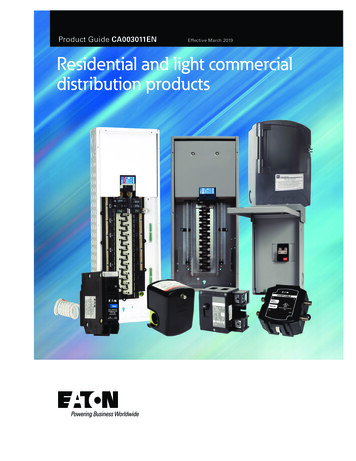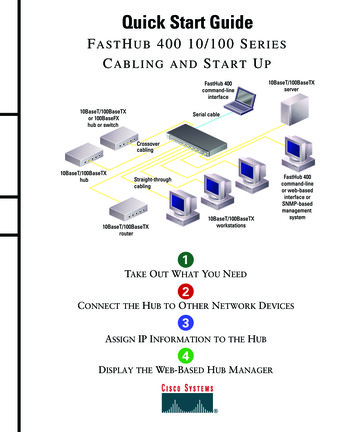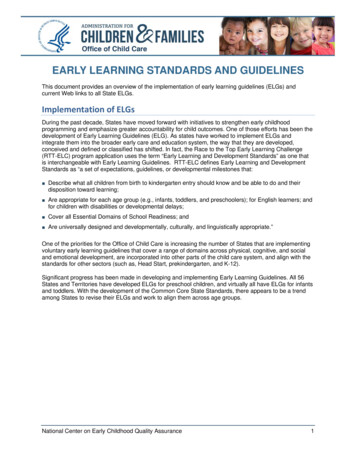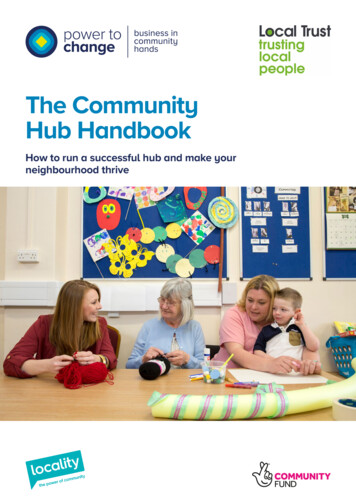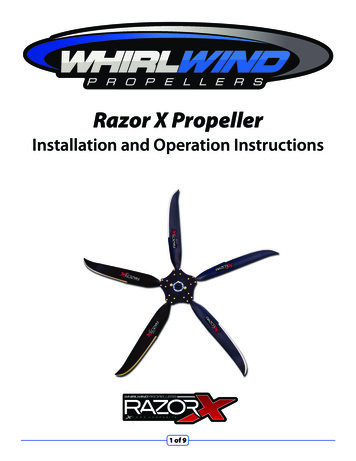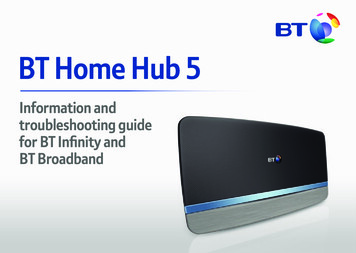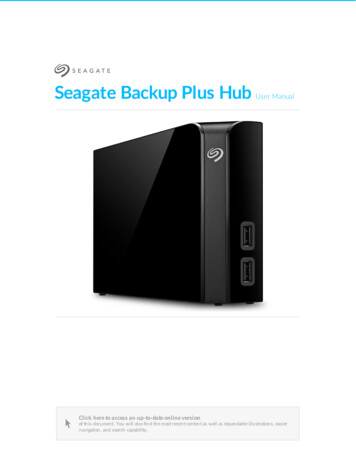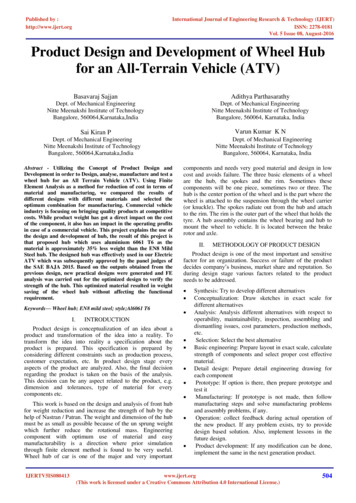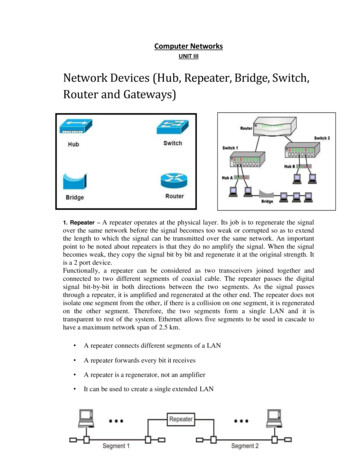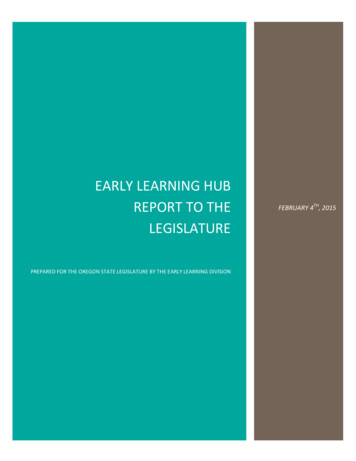
Transcription
EARLY LEARNING HUBREPORT TO THELEGISLATUREPREPARED FOR THE OREGON STATE LEGISLATURE BY THE EARLY LEARNING DIVISIONFEBRUARY 4TH, 2015
Early Learning Hub Legislative ReportCONTENTSExecutive Summary. 4Function of the Hubs. 4Shared Goals, Outcomes, and Indicators. 5Resources and Funding . 5Cross sector Collaboration and Family Engagement . 5Data and Data System . 6Support and Technical Assistance for Hubs . 6Recommendations . 6Introduction . 7Summary of Results . 8Current Status . 8Ingredients for Success . 9The Creation of the Early Learning Hubs . 10Technical Assistance and Support . 13Lessons learned from the Early Learning Hubs . 13Function, Organization, and Governance . 14Metrics, Outcomes, and Goals . 15Funding . 18Collaboration & Partnership . 19Family Engagement . 21Data . 22Technical Assistance and Support for the Early Learning Hubs. 22Proposed Recommendations . 22Early Learning Hub Pages . 24Early Learning Hub Inc. . 24Early Learning Multnomah. 25Lane Early Learning Alliance . 26South-Central Oregon Early Learning Hub. 28Yamhill Early Learning Hub . 30Frontier Oregon Services Early Learning Hub . 312
Early Learning Hub Legislative ReportBlue Mountain Early Learning Hub . 32Central Oregon Early Learning Hub . 33Southern Oregon Early Learning Services . 34Eastern Oregon Early Learning Hub . 35Early Learning Washington County Hub . 36Northwest Regional Early Learning Hub . 37Linn Benton Lincoln Early Learning Hub . 38Clackamas Early Learning Hub . 39Appendix I . 41Hub Metrics Committee Recommendations . 41Hub Metrics Committee Membership . 453
Early Learning Hub Legislative ReportEARLY LEARNING HUB LEGISLATIVE REPORT – 2015Executive SummaryIn 2013, the Oregon Legislature passed House Bill 2013. The resulting statute authorizes the EarlyLearning Council to create sixteen regional and community-based Early Learning Hubs in order to makesupports more available, more accessible, and more effective for children and families, particularlythose who are historically overrepresented in the opportunity gap and underrepresented in services.The Early Learning Hubs are directed by statute to accomplish three specific goals: (1) create an earlychildhood system that is aligned, coordinated, and family-centered; (2) ensure that children arrive atschool ready to succeed; and (3) ensure that Oregon’s young children live in families that are healthy,stable, and attached. Over the last year, fourteen Early Learning Hubs have formed across the state. TheEarly Learning Council awarded the first six Hub designations in November, 2013 and another eight areexpected to finalize contractual arrangements by June, 2015. An additional two Hubs are expected toreach readiness by June, 2015 for a total of sixteen (per HB 2013).Even in the relatively little time that Early Learning Hubs have had to form and get up and running, theyhave demonstrated a new approach that is focused on outcomes and committed to collaborating acrosssectors. Having clear goals has enabled the Hubs to be focused in their work and strategic in their use ofresources. Kindergarten readiness has served as the “north star,” helping Hubs and their partners orientthemselves. The Hubs have also already forged new partnerships across sectors that have never existedbefore. The partnerships forming between early learning, K-12 education, and health are a true successfor the Hubs. While the Hubs are united by a common vision and approach, the form that they aretaking and the particular strategies that they are adopting differ, reflecting the needs and assets of theirparticular communities.The Early Learning Hubs are clearly off to a promising start and have shown their potential for changingthe way that business is done and positively impacting the lives of Oregon’s most vulnerable childrenand families. Fully reaching this potential, changing the way that systems work and interact anddemonstrating population-level outcomes for children and families will take time. Early Learning Hubsneed the time, resources, and on-going support from the state to get there. Leadership, consensusbuilding, conflict resolution, and decision-making skills are essential to the success and sustainability ofHubs.The Early Learning Council, based on what has been observed of the Early Learning Hubs over the lastyear and the research it has conducted, offers the following observations:Function of the Hubs While Early Learning Hubs take different forms, reflecting the needs, resources, and values of theircommunities, the three statutory goals provide a unifying focus:o An early learning system that is aligned, coordinated, and family centered.o Children that arrive at kindergarten ready and supported for success.o Families that are healthy, stable, and attached.Early Learning Hubs are helping communities achieve these goals through a “collective impact”model in which their primary responsibilities are to:o Develop a common vision and strategic agenda that is shared across five sectors: earlylearning, health, human services, K-12 education, and private sector partners.4
Early Learning Hub Legislative Reporto Bring these sectors together to align strategies and resources, and pursue collaborativeinitiatives.o Engage parents and families so that Oregon’s early learning vision and agenda is guided byfamily voice.o Coordinate services, communication and data sharing across sectors.o Measure and evaluate progress through a shared set of metrics and indicators.Leadership, consensus building, conflict resolution and decision-making skills are needed by Hubsand will be important in ensuring sustainability.The direct provision of services is not, and should not be, a core function of Hubs. Hubs haveaddressed this by separating their collaborative and coordination responsibilities from direct serviceprovisions in Hubs where the backbone organization is also a direct service provider.Shared Goals, Outcomes and Indicators Having shared high-level goals and expectations for concrete outcomes has been extremelyimportant in helping the Early Learning Hubs bring partners to the table. The Hub metrics that are most concrete, measurable and actionable have played an important role infocusing the Hubs and providing guidance in the development of their work. Early Learning Hubs are still in formative stages. Indicators of their success at this stage need to bedifferent from indicators for later, more established stages of their development. Measurement and data challenges remain a barrier to constructing a more robust andcomprehensive set of quantitative metrics for the Hubs.Resources and Funding Funding for core early childhood programs, such as Oregon Prekindergarten, Relief Nurseries, andHealthy Families Oregon, should continue through the upcoming biennium to flow directly toprograms, but should be coordinated with local efforts at the direction of Hubs.The alignment, coordination, and family engagement functions of the Hub are time and laborintensive, and require resources if they are to be done effectively.In order to address gaps in services and implement plans to address them, Hubs need flexibleresources, including the ability to supplement the resources for and expand access to core statefunded early childhood programs.Cross sector Collaboration and Family Engagement The success of the Early Learning Hubs will largely depend upon their ability to forge new forms ofcollaboration and partnership across sectors, and the willingness of other sectors to engage.o The Hubs are demonstrating the ability to forge these collaborations, particularly with K-12education and health.Having financial resources to support shared initiatives is important to building cross sectorcommitment to the goals of HB 2013, as demonstrated by the success of the KindergartenPartnership Innovation Fund.Collaboration across sectors and partners is dependent on local relationships and often takes timeto deepen.Engaging the business sector remains challenging for Hubs.5
Early Learning Hub Legislative Report Hubs universally recognize that they will only be successful if they fully engage families and areguided by family voice. While Hubs have begun to raise family voice in a new ways, many alsorecognize this as an area that needs to be broadened and deepened.Hubs see K-12 education partners as most critical to achieving outcomes, and may need assistancefrom the state in strengthening their efforts to engage schools.Data and Data System The Hubs look to the state to address the challenges around data tracking and data integration.There is a lack of clarity and shared understanding of the key policy questions that need to beanswered by early childhood data efforts.Because early childhood data touches so many different “systems,” there is also not a sharedunderstanding of which state entity is responsible for developing the data system needed by Hubs.These issues need to be addressed as a precursor to assisting Hubs with data challenges.Support and Technical Assistance for Hubs Over the next biennium, the state will increase its accountability role related to Hubs. The state willhave a delicate balance to maintain: provide needed support and assistance to Hubs while at thesame time holding them accountable for reaching outcomes.As the Hubs continue to develop, the state’s technical assistance will need to become more tailoredto the specific needs of individual Hubs.Recommendations The Legislature should give the Early Learning Hubs permanent statutory status.The indicators and metrics recommended by the Hub Metrics Committee and adopted by the EarlyLearning Council should be incorporated in the Hub’s contracts when they are renewed.The Legislature should continue to provide funding for core early childhood programs, such asOregon Prekindergarten, Relief Nurseries, and Healthy Families Oregon, directly to the programsrather than directing those funds through the Early Learning Hubs.The Legislature, in accordance with the Governor’s Requested Budget, should adequately fund theEarly Learning Hubs to fulfill their coordination function.The Legislature should, in accordance with the Governor’s Requested Budget, provide Early LearningHubs with resources that they can directly invest in local programs in their community in order toaddress gaps in services and build stronger cross sector partnerships.The Early Learning Division, through technical assistance and, where possible, the allocation ofresources, should support the Hubs in deepening their work around family engagement andengaging culturally-specific community based organizations.The Early Learning Council, working with the Early Learning Division, should clarify the key policyquestions data systems need to be able to answer.The Early Learning Council, working with the OEIB Data Governance Committee, should develop afive-year strategic and investment plan for increasing data integration across early childhoodprograms and the early learning system.6
Early Learning Hub Legislative ReportIntroductionOver the last year, fourteen Early Learning Hubs have formed across the state. Two final Hubs areexpected to form and reach contract by June, 2015. The Oregon Legislature created the Early LearningHubs in order to make resources and supports more available, more accessible, and more effective forchildren and families who are historically overrepresented in the opportunity gap and underrepresentedin services. Hubs are building outcomes-focused collaborations across five sectors: K-12 education, earlylearning, health, human services, and business. Based on statutory guidance, each Hub identifies theunderserved children in its region, evaluates the needs of those children and families, and then works toensure that programs and services reach them and effectively meet their needs in order to ensure thatthey reach kindergarten ready to succeed in school.In 2013, the Oregon Legislature passed House Bill 2013 authorizing the Early Learning Council to createsixteen regional Early Learning Hubs in order to accomplish three goals: (1) create an early childhoodsystem that is aligned, coordinated, and family-centered; (2) ensure that children arrive at school readyto succeed; and (3) ensure that Oregon’s young children live in families that are healthy, stable, andattached. House Bill 2013 instructed the Early Learning Council to fund no more than seven EarlyLearning Hubs during fiscal year 2013-2014 and no more than a total of sixteen Hubs during fiscal year2014-2015. The Early Learning Council was also made responsible for maintaining continuity of servicessupported by funds that previously flowed through local Commissions on Children and Families.House Bill 2013 also required Early Learning Council to: “submit a report to the Legislative Assembly nolater than February 4, 2015. The report must include: (A) A summary of the results of the Early LearningHub Demonstration Projects; and (B) Proposed legislation that takes into consideration the results of theEarly Learning Hub Demonstration Projects and attempts to increase the effectiveness andsuccessfulness.”This report is submitted in compliance with this provision.7
Early Learning Hub Legislative Report(A) Summary of ResultsCurrent StatusOregon’s greatestopportunity forChart A-1future equity andprosperity is in thecreation of a worldclass educationsystem that startsearly and supportsthe success of allstudents. In 2011,the OregonLegislature approvedthe “40-40-20”educational goals forthe state: by 2025, 40% of adult Oregonians will earn a bachelor’s degree or higher; 40% will earn anassociate degree or post-secondary credential, and 20% will earn a high school diploma or equivalent.Early childhood experiences are the foundation upon which the “40-40-20” goals will or will not beachieved. Research is clear that giving children a strong start helps set them on a path toward futuresuccess in school and in life. Well before the start of kindergarten, a child’s brain has already created thefoundation for future learning and development (see chart A-1 above).Oregon has considerable work to do to achieve the “40-40-20” goal and ensure that children andfamilies are supported to be successful. The results of the fall 2014 Kindergarten Assessment show thatmany children are arriving at kindergarten without having had the experiences that will help them to besuccessful in school. Too many children have not had the opportunity to experience vocabulary-richenvironments where they are hearing stories read aloud to them, where rhyming and singing games areplayed together, and where adults spend time with them engaging in conversation about the worldaround them. As a result, too many children are arriving at kindergarten without the ability to quicklyrecall letter names or theirsounds. Many children are alsomissing opportunities toparticipate in early learningexperiences that intentionallydevelop the self-regulatory andinterpersonal skills that researchhas demonstrated is critical tosuccess in school (see Charts A-2and A-3).Chart A-28
Early Learning Hub Legislative Report9Chart A-3Chart A-4Research links early literacy, earlymath, and self-regulation andinterpersonal skills in kindergarten tothird grade reading proficiency. Thirdgrade reading proficiency, animportant predictor of high schoolgraduation, remains alarmingly low inOregon (see Chart A-4).Ingredients for SuccessWhen young children and familiesneed extra support, they shouldn’thave the added burden of navigatingmultiple sectors and processes. In order to better meet family needs, health providers, early learningproviders, parent educators, and schools and human services programs all need to work together. TheEarly Learning Hubs were created to make that collaboration happen and to help communities cometogether around a common vision for their young children and families. If the Early Learning Hubs aresuccessful, more Oregon children will arrive ready to succeed in kindergarten, more families will havethe resources and tools to create stable environments for their children, and services and programs willbe working together to provide what children and families most need.While communities have the flexibility to design their own Hub models and sets of strategies to achieveoutcomes, each Hub shares the following responsibilities: Identify children at-risk of arriving at kindergarten unprepared for school;Work with families to identify specific needs;Connect families to the supports or services that most meet their needs;Collaborate across sectors; andAccount for outcomes collectively and cost effectively.
Early Learning Hub Legislative ReportThe Creation of Early Learning HubsHouse Bill 2013 authorized the Early Learning Council to designate no more than nine Early LearningHubs during the first year of the biennium and up to seven more during the second year. This legislationalso stipulated that Hubs must: Coordinate the provision of early learning services to the community served by the Hub;Include service providers, parents, community members, county governments, school districts, andother stakeholders in the creation of the Hub;Align services coordinated by the Hub with services provided by public schools;Align services coordinated by the Hub with services provided by Coordinated Care Organizations andcounty public health departments;Integrate efforts across health, K-12 education, human services, early education, and the businesscommunity using coordinated and transparent budgeting and through a governing body withrepresentation of each of the above sectors as well as parents of children using early learningservices;Demonstrate an ability to improve results for at risk children;Leverage additional private and public funds – including in kind support; andKeep administrative overhead at 15% or lower.In August 2013, the Early Learning Council released a Request for Applications (RFA) for the first roundof Hubs with the RFAs due in October of that year. Both prior to the release of the RFA and during theperiod in which communities had to work on their application, the Early Learning Division providedtechnical assistance and support. This technical assistance included: (1) a series of webinars focused oncross sector collaboration, using data to drive decision-making and community asset mapping; (2) a fullday meeting to enable participants to go deeper on topics introduced in the webinars; and (3) applicantconferences conducted in Medford, Bend, Pendleton, and Portland.While the legislation capped the number of Early Learning Hubs at a total of sixteen, the territorycovered by particular Hubs was not defined in statute. It was left to communities to come together ontheir own to determine geographical regions and partnerships. However, Hubs must have distinct andnon-overlapping territories. While communities were asked to define Hub regions on their own, HB2013 empowered the Early Learning Council to alter the lines of territory served by Hubs to ensure thatall children in Oregon are served by an Early Learning Hub. The legislation instructed the Early LearningCouncil to oversee services in communities in which there is not a Hub ready to take on this function.The Early Learning Council left open the possibility for a Hub defined by a community of interest ratherthan geography. However, no RFAs of this kind were submitted in either round. Communities were alsoasked to choose the specific organization that would serve as the backbone and fiscal agent, and weregiven wide latitude as to the kind of organization they could choose to serve this function.The RFA asked applicants to demonstrate readiness in the following ways: A comprehensive strategy with articulated return on investment, including a strategic vision and afive-year strategic plan outlining the Hub’s goals and strategies for ensuring strong outcomes;A defined coverage area and clear evidence of cross sector coordination;A demonstrated understanding of the proposed coverage population, including equity, ability toserve at risk children, and a clear ability to coordinate and integrate high quality services for thesechildren;Business acumen and operational stability including an effective governance structure, and the useof a comprehensive children’s budget and a realistic plan for financial stability; and10
Early Learning Hub Legislative Report Accountability to outcomes, includingclear baselines for each required metricand ambitious but realistic targets forimprovement.Table A-5The Early Learning Council asked applicantsto indicate how they would achieve thefollowing placeholder outcomes andimprovement metrics (see Table A-5).Fifteen communities submitted applicationsin response to the first RFA and theapplications were scored by a twenty-sixmember evaluation team comprised of EarlyLearning Council members andrepresentatives from the Oregon HealthAuthority, the Department of HumanServices, the Oregon Department of Education, and the Department of Administrative Services. Scoreswere reviewed by an Award Team, comprised of two Early Learning Council members, the Early LearningSystems Director, the Governor’s Labor and Human Services Policy Advisor, and the Deputy ChiefOperating Officer for the state. The Award Team made the final recommendations to the Early LearningCouncil.The Award Team’s recommendations, which were approved by the Early Learning Council in Novemberof 2013, were to award one contract to Early Learning Hub, Inc., covering Marion County and to enterinto contract negotiations with five additional applicants that had made a strong start in their proposal,but where additional work was need to demonstrate complete readiness. These applicants were: Frontier Oregon Services Hub (Grant, Harney)South Central Oregon Early Learning Hub (Douglas, Lake)Lane Early Learning Alliance HubEarly Learning MultnomahYamhill Early Learning HubBased on specific areas that the Award Team had identified for needing improvement or clarification,Early Learning Division staff worked with the applicants to develop revised strategic plans and othersupplemental material. By May, 2014 contracts had been signed with all five of these Hubs.The process for designating Hubs was repeated with a second Request for Applicants released in April,2014 and recommendations by the Award Team made to the Early Learning Council in June, 2014.Applicants from this round were broken into three groups: Ready to move to contract negotiation;Ready to enter negotiations after significant technical assistance prior to award; andNot ready yet.Table A-6: Second Round Hub RecommendationsFully ReadyReady with SupportSouthern Oregon EarlyLearning Services (Jackson,Not ReadyClackamas Early Learning Hub South Coast Regional EarlyLearning Hub (Coos, Curry)11
Early Learning Hub Legislative ReportFully ReadyReady with SupportNot ReadyJosephine)Wellness and EducationBoard of Central Oregon(Crook, Deschutes, andJeffersonEastern Oregon Hub (Baker,Malheur and Wallowa)Blue Mountain Early LearningHub (Morrow, Umatilla andMorrow)Linn Benton Lincoln EarlyLearning HubFour Rivers Early LearningHub (Sherman, Gilliam,Wasco, Wheeler and Hood)Northwest Early LearningCouncil (Columbia, Clatsopand Tillamook)Washington County EarlyLearning HubTable A-6 indicates status of each applicant in the second round. In addition, the Early Learning Counciladopted the Award Team’s recommendation that Polk County join Early Learning Hub, Inc. and that LakeCounty combine with South Central Oregon Early Learning Hub.As of January 1, 2015, all five of the “fully ready” and two of the “ready with assistance” Hubs havereached contract. The remaining three “ready with assistance” Hubs are anticipated to have a signedcontract within the next month and Four Rivers and the South Coast are expected to reach contract byJune. With the creation of the final two Hubs and the completion of the recommended county mergers,all areas in Oregon will be covered by an Early Learning Hub. These final two Hubs will bring the totalnumber to sixteen, the maximum number allowed under House Bill 2013 (see Chart A-7).Chart A-712
Early Learning Hub Legislative ReportTechnical Assistance and SupportThe Early Learning Division has continued to provide technical assistance and support to Hubs after theyreach contract. The Early Learning Division has contracted with the Oregon Solutions Network to providesupport leading up to contracting, as well as to help facilitate the merger of Polk and Lake Counties withpre-existing Hubs. In addition to direct support from Early Learning Division staff on meeting reportrequirements and contract deliverables, contracted Hubs also participate in the Hub LearningCollaborative.During this start-up stage, the Early Learning Division has sought to maintain continuity of funding andservices for resources that formally flowed to communities through the local Commissions on Childrenand Families. Where Hubs have formed with sufficient time to effectively plan and allocate their use,Great Start and Family Support funding has been transferred to the Hubs. In other cases, these fundshave either continued to flow through the counties or directly to the programs that they have previouslysupported.Lessons learned from the Early Learning HubsIn preparation for this report, Early Learning Division staff interviewed Hub leaders, board members,and partners. Hubs that had reached contract were surveyed in early December 2014. Input andinformation was also solicited from Hubs during Learning Collaborative meetings. Key documents,including the Hub’s monthly reports to the Early Learning Division were also reviewed. This report hasalso been informed by the work of the Early Learning Hubs Metrics Committee, which met bi-weeklyfrom August to December of 2014.An assessment of what has been learned from the Early Learning Hub Demonstration Projects mustbegin with an acknowledgement of how new the Hubs are
Feb 04, 2015 · learning, health, human services, K-12 education, and private sector partners. Early Learning Hub Legislative Report 5 o Bring these sectors together to align strategies and resources, and pursue collaborative initiatives. o Engage parents and families so that Oregon’s early
